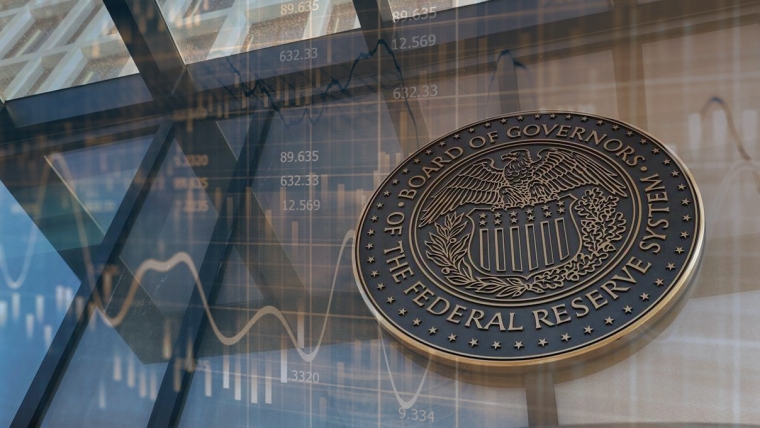
In the United States, the long-term real safe interest rate – the inflation-adjusted return on low-risk investments such as Treasuries – is, in addition to “financial conditions,” the key mechanism influencing both the incentive to build and the balance of net exports (owing to its effect on the exchange rate).
From early March to mid-May 2022, this metric jumped by more than one percentage point as the bond market realized that the US Federal Reserve would soon curtail its efforts to promote a speedy recovery in employment following the pandemic. Then, from late August to early October 2022, it jumped again, this time by an annualized 1.5 percentage points, as bond traders speculated that the Fed might have to tighten monetary policy to avert persistent inflation in an economy that had returned to full employment.
It was these two spikes that created the current interest-rate configuration. Rates today are far higher – around two percentage points – than the level anyone five years ago (before the pandemic) would have estimated the “neutral” rate to be.
The neutral rate, John Maynard Keynes explains in The General Theory of Employment, Interest, and Money, is the level necessary to “bring about an adjustment between the propensity to consume and the inducement to invest.” An interest rate that everyone considers to be above the neutral level therefore reflects markets’ confidence that a recession – or at least a substantial slowdown – is only a matter of time. When that time comes, all will depend on whether the Fed recognizes the approaching weakness in time to cut rates and achieve a “soft landing.” This interest-rate configuration has now held for seven months.
The situation has not been fully static, of course. There was another one-point surge between June and October 2023. But that wave soon receded as speculation shifted to questions of when and how fast the Fed would start cutting rates. The 30-year Treasury rate thus is back to where it was in October 2022.
The landing has indeed been smooth. But the pilot has not dared to shift from reverse into neutral. Apparently, the Fed is concerned that nonfarm payrolls keep rising. On a seasonally adjusted basis, there were 275,000 more jobs in February than in January, which is only slightly higher than the average of 250,000 over the past six months. I suspect that the Fed is profoundly uncomfortable with interest rates substantially above what it confidently believes the neutral rate to be, especially now that inflation is very close to its 2% target. But it will not dare to shift out of reverse until it sees signs of slower job growth.
Three explanations could clarify the current situation. The conclusion that interest rates are in excess of the neutral rate could be based on an erroneous analysis. Or there could be an error in how we measure the state of the economy. Or, third, the Fed may have committed the Wile E. Coyote error.
Taking these explanations in reverse order, if economic weakness is indeed coming, the Fed will soon wish that it had started cutting rates in January 2024. Remember, private-sector decisions to cut back on building, and to re-source purchases to overseas suppliers, were paused in 2022 and delayed until 2023 as people waited to see how much the Fed would tighten. If firms then followed through on those postponed decisions between May and October 2023 – as the ten-year Treasury yield ran up temporarily from 3.53% to 4.93% – the impact on employment patterns should start to hit the economy right about now.
In pursuit of the roadrunner, Wile E. Coyote (a classic Looney Tunes character) always runs off the edge of the cliff but does not begin to fall until he looks down and realizes he’s running in air. I was fairly confident that this was where the Fed stood six months ago. But as time passes without anything happening, I become more torn.
What if the measurements are wrong? The consensus has long been that the US payroll survey is superior to the household survey. But in the past couple of years, a gap has emerged between these two surveys. While the payroll survey records 2.7 million more jobs than a year ago, the household survey records only 700,000 more people working in those jobs than a year ago.
If the labor market is as weak as the household survey suggests, that weakness should have already shown up in consumer spending. It has not.
That leaves the possibility of a faulty analysis. The near-consensus since the start of the pandemic has been that there are powerful fundamental factors keeping the neutral interest rate very low, and that there have been no major changes to those fundamentals. The neutral rate therefore should still be very low, implying that the high policy rate is inappropriate to an economy at full employment with inflation near its target.
But if there is one lesson that I have learned in more than 40 years of trying to understand the business cycle, it is that there is no empirical regularity in the macroeconomy that can be trusted not to crumble beneath our feet in a remarkably short time.
J. Bradford DeLong, a former deputy assistant US Treasury secretary, is Professor of Economics at the University of California, Berkeley, a research associate at the National Bureau of Economic Research, and the author of Slouching Towards Utopia: An Economic History of the Twentieth Century (Basic Books, 2022). Copyright: Project Syndicate, 2024, and published here with permission.
7 Comments
The near-consensus since the start of the pandemic has been that there are powerful fundamental factors keeping the neutral interest rate very low, and that there have been no major changes to those fundamentals.
This is what Milton Friedman called the interest rate fallacy, and it indeed refuses to die. We can tell what monetary conditions are in the real economy, as opposed to financial liquidity, though the two can be linked, by the general level of interest rates. When money is plentiful, interest rates will be high not low; and when money is restricted, interest rates will be low not high. The reason is as Wicksell described more than a century ago:
[The natural rate] is never high or low in itself, but only in relation to the profit which people can make with the money in their hands, and this, of course, varies. In good times, when trade is brisk, the rate of profit is high, and, what is of great consequence, is generally expected to remain high; in periods of depression it is low, and expected to remain low.
When nominal profits are expected to be robust, holders of money must be compensated for lending it out by higher interest rates. Thus, the same holds for inflationary circumstances, where nominal profits follow the rate of consumer prices. During the Great Inflation, interest rates weren’t low at all, they were through the roof well into double digits and higher by 1980. At the opposite end in the Great Depression, interest rates were low and stayed there because, as Wicksell wrote, the rate of profit was low and was expected to be low well into the future. High quality borrowers were given as much money as they could want while the rest of the economy was deprived of funds; liquidity and safety being the only preferences in what sounds entirely familiar. Link
Consequences:
The U.S. Navy is pushing back the start of construction on its next-generation attack submarine by nearly a decade, citing tight budgets and a need to fund current and near-term operations. A Navy spokesperson told Defense News construction on the lead ship of the SSN(X) program, which will follow the Virginia-class attack submarine, is now planned to start in the “early 2040s.” The Navy last year planned to begin the ship class in 2035, and it was previously set for a 2031 start. In its fiscal 2025 budget, the Navy is seeking to delay spending on several modernization programs, including SSN(X), the DDG(X) next-generation destroyer, and the F/A-XX next-generation fighter. Link
Could it be because interest rates are a much bigger driver of inflation than you thought (and all your models are based on voodoo economics)? Just a thought.
By "you", you mean The Fed?
You could well be right. There's precious little study on how higher i-rates (i.e. above the neutral rate) for prolonged periods affect inflation in a modern economy as the assumption has always been that such action was a) temporary and b) necessary. We do have lots of great info about how steadily ratcheting up rates effects an economy as the GFC provided a useful study. Seems the Fed is intent on not repeating a failure from the past but may be creating a whole new failure. As Splitz Enz observed, "history never repeats;. ;-)
My faith doesn't extend to there being a 'neutral rate'. The idea of the economy ever being in equilibrium is weird to me - but then I spent my early career modelling the flow of, errrm, 'very dirty liquids' through water treatment plants, so I know that changing one variable in a complex system can have very different impacts on other variables depending on the conditions.
My general view on the US is that the wider actions of the Fed and Govt are dominant - e.g. Fed accepting collateral at par rather than mark to market, wider bank safeguards, huge Govt fiscal investment, the interest income channel, and existing mortgagors being insulated almost entirely from rate rises. Given this, the only sector you would expect to be suffering would be commercial real estate (check)- and even that sector seems to be turning the corner as the market adjusts to higher rates (it's the change in rates that has the impact after all).
It's a good point and intuitive enough.
Reminds me of the statistic shared during the period where fruit and veg prices were going through the roof: of the increased input costs for farmers, debt servicing was 90% of it. It was unclear whether this was due to any new debt brought about by the recent circumstances but I doubt it very much.
Pretty much sums up how I'm understanding US Fed rates. A very confusing picture.
NZ's picture is far less confusing. IMO the RBNZ is way behind the 8-ball because it is using old data and poor projections.

We welcome your comments below. If you are not already registered, please register to comment
Remember we welcome robust, respectful and insightful debate. We don't welcome abusive or defamatory comments and will de-register those repeatedly making such comments. Our current comment policy is here.